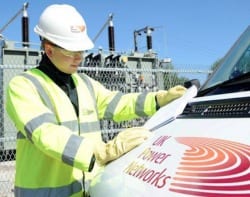 British utility UK Power Networks appears to have found a way to make energy storage pay — even if it doesn’t look that way at first.
British utility UK Power Networks appears to have found a way to make energy storage pay — even if it doesn’t look that way at first.
The company has built a business case to justify an £11.4 million ($17.4 million) investment in battery storage, despite it costing £6.3 million ($9.6 million) more than conventional grid reinforcement measures.
For more than a year, UK Power Networks has been testing a 6-megawatt/10-megawatt-hour battery storage system as a way to harden a local substation. Figures unveiled last month show how the lifetime installed cost of the Smarter Network Storage (SNS) facility in Leighton Buzzard, U.K., could be offset by savings and revenues worth up to about £8 million ($12.2 million) over the life of the project.
The biggest chunk of savings, assuming the project is scaled for other areas of the grid, comes simply from the drop in price of battery technology in the year since SNS was commissioned.
The battery storage system was deployed in early 2013. Consequently, the business case today would have to be adjusted to account for cuts of up to 30 percent in battery prices.
This alone would knock £2.9 million ($4.4 million) off the cost compared to the initial project, said Nick Heyward, SNS project lead. And a further £2.6 million ($4 million) could be deducted through future income streams made possible by the facility.
In addition, load-balancing services could generate between £300,000 and £400,000 ($457,000 and $610,000) a year, according to UK Power Networks’ estimates.
This still leaves SNS about £800,000 ($1.2 million) short of beating the cost of traditional grid reinforcement measures such as building new overhead lines and primary transformers.
However, the utility believes that SNS could deliver around £2.5 million ($3.8 million) in what it calls “societal benefits,” such as displacing the need for additional peak generation capacity and reducing carbon emissions.
Such profits, Heyward said, do not always flow back to the corporate balance sheet. This represents a blind spot in regulatory schemes not just in the U.K., but also in many other markets.
The SNS project is important not just in helping to show how grid-scale energy storage could make financial sense in practice, but also in delivering real-life data on costs and benefits to the wider utility sector.
A breakdown of project costs shows, for example, that capital expenditure on storage technology accounted for 69 percent of the total lifetime installed cost of the project. Operational costs, over an estimated 10 years, represented a further 9 percent.
The remaining 23 percent corresponds to design work, civil and electrical engineering, and the like. Within this area, one-third was typical civil engineering work that would need to be carried out in any project of similar characteristics.
A further quarter of that 23 percent (5.75 percent of the overall cost) was typical electrical work.
About 4 percent of the overall cost was on project-specific work such as raising the battery warehouse 2 meters above the ground to avoid flooding risks, since SNS was built on a flood plain.
SNS, a 765-square-meter, purpose-built facility featuring 12 arrays of 264 Samsung lithium-ion battery strings with advanced management systems, was built to create maximum value for the distribution network operator.
UK Power Networks has an energy supply and tolling agreement with SmartestEnergy, Britain’s leading purchaser of independent energy generation. It also has an aggregator services agreement with KiWi Power, a demand response company.
Working with these partners, UK Power Networks can offer response and reserve services to the grid, wholesale energy market buying and selling, peak shaving, reactive power, and voltage support for its own network.
The facility was built with £13.2 million ($20.1 million) from the Low Carbon Networks Fund provided by the U.K. Office of Gas and Electricity Markets.
UK Power Networks put in a further £4 million ($6.1 million), and the remaining funding came from project partners including SmartestEnergy and KiWi Power, plus AMT-Sybex, Swanbarton, Pöyry, Newcastle University, National Grid and Imperial College London.
Source: Greentech Media. Reproduced with permission.










